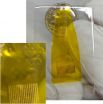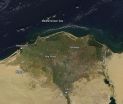Pinning down the details of how individual neural circuits operate in epilepsy and other neurological disorders requires real-time observation of their locations, firing patterns, and other factors, using high-resolution optical imaging and electrophysiological recording. But traditional metallic microelectrodes are opaque and block the clinician's view and create shadows that can obscure important details. In the past, researchers could obtain either high-resolution optical images or electrophysiological data, but not both at the same time.
The Center for NeuroEngineering and Therapeutics (CNT), under the leadership of senior author Brian Litt, PhD, has solved this problem with the development of a completely transparent graphene microelectrode that allows for simultaneous optical imaging and electrophysiological recordings of neural circuits. Their work was published this week in Nature Communications.
"There are technologies that can give very high spatial resolution such as calcium imaging; there are technologies that can give high temporal resolution, such as electrophysiology, but there's no single technology that can provide both," says study co-first-author Duygu Kuzum, PhD. Along with co-author Hajime Takano, PhD, and their colleagues, Kuzum notes that the team developed a neuroelectrode technology based on graphene to achieve high spatial and temporal resolution simultaneously.
Aside from the obvious benefits of its transparency, graphene offers other advantages: "It can act as an anti-corrosive for metal surfaces to eliminate all corrosive electrochemical reactions in tissues," Kuzum says. "It's also inherently a low-noise material, which is important in neural recording because we try to get a high signal-to-noise ratio."
While previous efforts have been made to construct transparent electrodes using indium tin oxide, they are expensive and highly brittle, making that substance ill-suited for microelectrode arrays. "Another advantage of graphene is that it's flexible, so we can make very thin, flexible electrodes that can hug the neural tissue," Kuzum notes.
In the study, Litt, Kuzum, and their colleagues performed calcium imaging of hippocampal slices in a rat model with both confocal and two-photon microscopy, while also conducting electrophysiological recordings. On an individual cell level, they were able to observe temporal details of seizures and seizure-like activity with very high resolution. The team also notes that the single-electrode techniques used in the Nature Communications study could be easily adapted to study other larger areas of the brain with more expansive arrays.
The graphene microelectrodes developed could have wider application. "They can be used in any application that we need to record electrical signals, such as cardiac pacemakers or peripheral nervous system stimulators," says Kuzum. Because of graphene's nonmagnetic and anti-corrosive properties, these probes "can also be a very promising technology to increase the longevity of neural implants." Graphene's nonmagnetic characteristics also allow for safe, artifact-free MRI reading, unlike metallic implants.
Kuzum emphasizes that the transparent graphene microelectrode technology was achieved through an interdisciplinary effort of CNT and the departments of Neuroscience, Pediatrics, and Materials Science at Penn and the division of Neurology at CHOP.
Ertugrul Cubukcu's lab at Materials Science and Engineering Department helped with the graphene processing technology used in fabricating flexible transparent neural electrodes, as well as performing optical and materials characterization in collaboration with Euijae Shim and Jason Reed. The simultaneous imaging and recording experiments involving calcium imaging with confocal and two photon microscopy was performed at Douglas Coulter's Lab at CHOP with Hajime Takano. In vivo recording experiments were performed in collaboration with Halvor Juul in Marc Dichter's Lab. Somatasensory stimulation response experiments were done in collaboration with Timothy Lucas's Lab, Julius De Vries, and Andrew Richardson.
As the technology is further developed and used, Kuzum and her colleagues expect to gain greater insight into how the physiology of the brain can go awry. "It can provide information on neural circuits, which wasn't available before, because we didn't have the technology to probe them," she says. That information may include the identification of specific marker waveforms of brain electrical activity that can be mapped spatially and temporally to individual neural circuits. "We can also look at other neurological disorders and try to understand the correlation between different neural circuits using this technique," she says.
INFORMATION:
The work was supported by grants from the National Institutes of Health (R01-NS063039, 1U24 NS 63930-01A1, R01-NS038572, RO1-NS082046), Citizens United for Research in Epilepsy (CURE) through the Julie's Hope Award, and the Mirowski Family Foundation.
Penn Medicine is one of the world's leading academic medical centers, dedicated to the related missions of medical education, biomedical research, and excellence in patient care. Penn Medicine consists of the Raymond and Ruth Perelman School of Medicine at the University of Pennsylvania (founded in 1765 as the nation's first medical school) and the University of Pennsylvania Health System, which together form a $4.3 billion enterprise.
The Perelman School of Medicine has been ranked among the top five medical schools in the United States for the past 17 years, according to U.S. News & World Report's survey of research-oriented medical schools. The School is consistently among the nation's top recipients of funding from the National Institutes of Health, with $392 million awarded in the 2013 fiscal year.
The University of Pennsylvania Health System's patient care facilities include: The Hospital of the University of Pennsylvania -- recognized as one of the nation's top "Honor Roll" hospitals by U.S. News & World Report; Penn Presbyterian Medical Center; Chester County Hospital; Penn Wissahickon Hospice; and Pennsylvania Hospital -- the nation's first hospital, founded in 1751. Additional affiliated inpatient care facilities and services throughout the Philadelphia region include Chestnut Hill Hospital and Good Shepherd Penn Partners, a partnership between Good Shepherd Rehabilitation Network and Penn Medicine.
Penn Medicine is committed to improving lives and health through a variety of community-based programs and activities. In fiscal year 2013, Penn Medicine provided $814 million to benefit our community.






